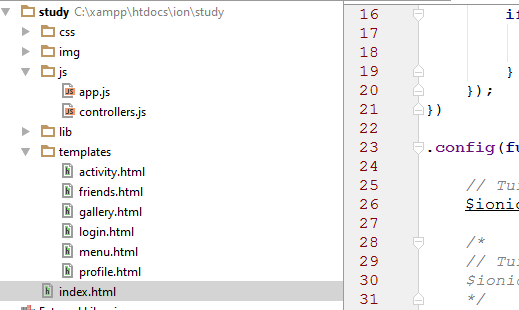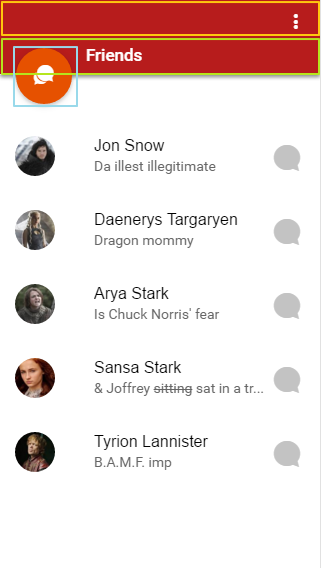เนื้อหานี้ต่อจากตอนที่แล้ว
ศึกษาและใช้งาน ionic material จาก demo เบื้องต้น
https://www.ninenik.com/content.php?arti_id=696 via @ninenik
จริงๆ แล้วเนื้อหาส่วนนี้จะมีอยู่ในบทความเก่า เกี่ยวกับ navigation และ template
การใช้งาน navigation ใน ionicframework ตอนที่ 5
https://www.ninenik.com/content.php?arti_id=541 via @ninenik
สามารถย้อนกลับไปศึกษาเพิ่มเติมได้ แต่ในที่นี้
เราจะทำการศึกษาาจากไฟล์ demo ว่ามีการทำงาน การประยุกต์ และมีรูปแบบที่น่า
เอามาต่อยอดได้เป็นอย่างไรบ้าง
มาดูโครงสร้างของ demo จากเนื้อหาตอนที่แล้ว

จากรูป เราจะสนใจในส่วนของไฟล์ app.js controller.js
และก็ไฟล์ในส่วนของ template
ไฟล์ app.js ตัด comment ออก
1 2 3 4 5 6 7 8 9 10 11 12 13 14 15 16 17 18 19 20 21 22 23 24 25 26 27 28 29 30 31 32 33 34 35 36 37 38 39 40 41 42 43 44 45 46 47 48 49 50 51 52 53 54 55 56 57 58 59 60 61 62 63 64 65 66 67 68 69 70 71 72 73 74 75 76 77 78 79 80 81 82 83 84 85 86 87 88 89 90 91 92 93 94 95 96 97 98 99 100 101 102 103 104 105 106 107 | angular.module('starter', ['ionic', 'starter.controllers', 'ionic-material', 'ionMdInput']).run(function($ionicPlatform) { $ionicPlatform.ready(function() { if (window.cordova && window.cordova.plugins.Keyboard) { cordova.plugins.Keyboard.hideKeyboardAccessoryBar(true); } if (window.StatusBar) { StatusBar.styleDefault(); } });}).config(function($stateProvider, $urlRouterProvider, $ionicConfigProvider) { $ionicConfigProvider.views.maxCache(0); $stateProvider.state('app', { url: '/app', abstract: true, templateUrl: 'templates/menu.html', controller: 'AppCtrl' }) .state('app.activity', { url: '/activity', views: { 'menuContent': { templateUrl: 'templates/activity.html', controller: 'ActivityCtrl' }, 'fabContent': { template: '<button id="fab-activity" class="button button-fab button-fab-top-right expanded button-energized-900 flap"><i class="icon ion-paper-airplane"></i></button>', controller: function ($timeout) { $timeout(function () { document.getElementById('fab-activity').classList.toggle('on'); }, 200); } } } }) .state('app.friends', { url: '/friends', views: { 'menuContent': { templateUrl: 'templates/friends.html', controller: 'FriendsCtrl' }, 'fabContent': { template: '<button id="fab-friends" class="button button-fab button-fab-top-left expanded button-energized-900 spin"><i class="icon ion-chatbubbles"></i></button>', controller: function ($timeout) { $timeout(function () { document.getElementById('fab-friends').classList.toggle('on'); }, 900); } } } }) .state('app.gallery', { url: '/gallery', views: { 'menuContent': { templateUrl: 'templates/gallery.html', controller: 'GalleryCtrl' }, 'fabContent': { template: '<button id="fab-gallery" class="button button-fab button-fab-top-right expanded button-energized-900 drop"><i class="icon ion-heart"></i></button>', controller: function ($timeout) { $timeout(function () { document.getElementById('fab-gallery').classList.toggle('on'); }, 600); } } } }) .state('app.login', { url: '/login', views: { 'menuContent': { templateUrl: 'templates/login.html', controller: 'LoginCtrl' }, 'fabContent': { template: '' } } }) .state('app.profile', { url: '/profile', views: { 'menuContent': { templateUrl: 'templates/profile.html', controller: 'ProfileCtrl' }, 'fabContent': { template: '<button id="fab-profile" class="button button-fab button-fab-bottom-right button-energized-900"><i class="icon ion-plus"></i></button>', controller: function ($timeout) { } } } }) ; $urlRouterProvider.otherwise('/app/login');}); |
จะอธิบายและศึกษาเฉพาะส่วน หากใครเริ่มต้นศึกษา แนะนำให้อ่านบทความเกี่ยวกับ ionicframework
ในตอนต้นๆ ก่อนเพื่อความเข้าใจ
1 | angular.module('starter', ['ionic', 'starter.controllers', 'ionic-material', 'ionMdInput']) |
โค้ดส่วนนี้ เป็นการลงทะเบียนและเรียกใช้ angular modules
starter คือ ชื่อ module ที่เรากำหนดในไฟล์ index.html
1 2 3 | <body ng-app="starter"> <ion-nav-view></ion-nav-view></body> |
สวน starter.controllers คือ ชื่อ module ที่เรียกใช้จากไฟล์ controllers.js
1 2 3 4 5 | /* global angular, document, window */'use strict';angular.module('starter.controllers', []).......... |
ส่วนค่าอื่นๆ ที่เหลือก็เป็นชื่อ module ที่เรามีการใช้งานร่วมกับ app ของเรา
ได้แก่ ionic , ionic-material , ionMdInput
โค้ดส่วนต่อมา
1 2 3 4 5 6 7 8 9 10 | .run(function($ionicPlatform) { $ionicPlatform.ready(function() { if (window.cordova && window.cordova.plugins.Keyboard) { cordova.plugins.Keyboard.hideKeyboardAccessoryBar(true); } if (window.StatusBar) { StatusBar.styleDefault(); } });}) |
โค้ดส่วนนี้ให้ข้ามไปก่อน เรายังไม่สนใจ
ส่วนที่เราให้ความสนใจ และต้องการศึกษาในตอนนี้คือส่วนของ
1 2 3 4 5 6 7 8 9 10 11 12 13 14 15 16 17 18 19 20 21 22 23 24 25 | .config(function($stateProvider, $urlRouterProvider, $ionicConfigProvider) { $ionicConfigProvider.views.maxCache(0); $stateProvider.state('app', { url: '/app', abstract: true, templateUrl: 'templates/menu.html', controller: 'AppCtrl' }) .state('app.activity', { url: '/activity', views: { 'menuContent': { templateUrl: 'templates/activity.html', controller: 'ActivityCtrl' }, 'fabContent': {............... $urlRouterProvider.otherwise('/app/login');}); |
สำหรับโค้ดในส่วนนี้ เหมือนการวางโครงสร้างว่า app ของเราจะมีหน้าไหนบ้าง
state ก็เหมือนส่วนของตำแหน่งของการแสดง app ของเรา เช่น
state เริ่มต้นชื่อว่า app มื child state เป้น app.activity และอื่นๆ
เรามาดูว่าโค้ดตัวอย่างของเรามี state อะไรบ้าง
- ส่วนแรกสุดเป็น parent state ชื่อ ว่า app
- ส่วนทีสองเป็น child state ได้แก่ activity ,friends, gallery, login, profile
เวลากำหนดเราจะใช้รูปแบบ parent.child ตัวอย่างถ้าเป็น state activity
ก็จะกำหนดได้เป้น app.activity แบบนี้เป็นต้น
ส่วนต่อไปเรามาดู url หรือก็ส่วนที่แสดงบน address bar ของแต่ละ state
1 2 3 4 5 6 7 8 9 10 11 12 13 14 15 16 17 18 19 20 21 22 23 24 25 26 27 28 | $stateProvider.state('app', { url: '/app', abstract: true, templateUrl: 'templates/menu.html', controller: 'AppCtrl'}).state('app.activity', { url: '/activity',}).state('app.friends', { url: '/friends',}).state('app.gallery', { url: '/gallery',}).state('app.login', { url: '/login',}).state('app.profile', { url: '/profile',});$urlRouterProvider.otherwise('/app/login'); |
รูปแบบก็จะเป้น '/ชื่อ state' เช่นถ้าเราเปิดหน้า app ไปที่หน้า profile
url ที่แสดงบน address bar ก็จะเป้น #/app/profile
สังเกตว่า prfile จะเป็น child state ของ app ที่เป็น parent state
url ของ app ที่เป็น parent state คือ '/app'
url ของ profile ที่เป็น child state คือ '/profile'
url ของ address bar ของ app.profile state ก็จะได้เป้น #/app/profile แบบนี้เป็นต้น
(# คือรูปแบบการจัดการ url ของ hybrid app ซึ่งจะต่างกับรูปแบบเว็บทั่วไป ต่อไปจะขอละ # มีพิมพ์แสดง
ให้เข้าใจว่าจะมี # นำหน้าเสมอ)
ต่อมา มาดูในส่วนของ parent state
1 2 3 4 5 6 | $stateProvider.state('app', { url: '/app', abstract: true, templateUrl: 'templates/menu.html', controller: 'AppCtrl'}) |
จะมีส่วนของการกำหนด abstract ,templateUrl: และ controller
abstract: true, ก็คือกำหนดให้ parent state นี้มีสถานะเป็น abstract state
Abstract state นี้จะไม่ถูกใช้งานหรือ activated ด้วมันเอง ซึ่งก็คือ เราไม่สามารถเรียกใช้งาน
ผ่าน /app ปกติเพื่อให้ state นี้ทำงานได้ แต่ state นี้จะถูกใช้งานอัตโนมัติเมื่อ child state ถูกเรียกใช้
เช่นเมื่อเรียกใช้งาน /app/profile ซึ่งเป็น child state ดังนี้แล้ว app ชื่อเป็น parent state ก็จะถูก
เรียกใช้งานในทางอ้อมไปด้วย โดยมีการเรียกไฟล์ template มาใช้งานและสร้าง ชื่อ controller
ดังนั้น เมื่อเรามีการเรียกใช้งาน /app/profile
ก็จะไปดึงรูปแบบการแสดงผลจากไฟล์ menu.html ผ่าน templateUrl
1 | templateUrl: 'templates/menu.html', |
และก็มีการสร้าง controller ชื่อ AppCtrl ขึ้นผ่าน
1 | controller: 'AppCtrl' |
ต่อไปเรามาดูส่วนของ child state จะสังเกตเห็นว่า รูปแบบการใช้งานก็จะคล้ายกัน
เปลี่ยนค่าไปตามส่วนที่กำหนด ขอยกมาสัก state มาอธิบาย
1 2 3 4 5 6 7 8 9 10 11 12 13 14 15 16 17 | .state('app.activity', { url: '/activity', views: { 'menuContent': { templateUrl: 'templates/activity.html', controller: 'ActivityCtrl' }, 'fabContent': { template: '<button id="fab-activity" class="button button-fab button-fab-top-right expanded button-energized-900 flap"><i class="icon ion-paper-airplane"></i></button>', controller: function ($timeout) { $timeout(function () { document.getElementById('fab-activity').classList.toggle('on'); }, 200); } } }}) |
แยกมาดูส่วนของ views
1 2 3 4 5 6 7 8 9 10 11 | .state('app.activity', { url: '/activity', views: { 'menuContent': { }, 'fabContent': { } }}) |
views ของแต่ละ state ก็คือ ส่วนของการแสดงข้อมูลซึ่งเราสามารถแยกย่อยไปแต่ละส่วนได้
เรากลับไปดูที่ไฟล์ menu.html ที่เป็น template แรกที่ถูกโหลดมาใช้งาน โดยดูโครงสร้าง app ประกอบ
ตามรูป


ดูโค้ดไฟล์ menu.html ประกอบ
1 2 3 4 5 6 7 8 9 10 11 12 13 14 15 16 17 18 19 20 21 22 | <ion-side-menus enable-menu-with-back-views="true"> <ion-side-menu-content> <ion-nav-bar class="bar-assertive-900" ng-class="{expanded: isExpanded, 'has-header-fab-left': hasHeaderFabLeft, 'has-header-fab-right': hasHeaderFabRight}" align-title="left"><!-- ส่วนหัวของ app หรือส่วนของ bar จากรูปด้านบนก็จะเป้นส่วนขอกรอบงสี่เหลี่ยมสีเหลือง--> </ion-nav-bar> <ion-nav-view name="fabContent"><!-- ส่วนของไอค่อนเมนูย่อย ส่วนของกรอบสีเขียวและฟ้า--> </ion-nav-view> <ion-nav-view name="menuContent" ng-class="{expanded: isExpanded}" ><!-- เนื้อหาของ app จะแสดงในส่วนนี้ ส่วนของกรอบสีม่วง--> </ion-nav-view> </ion-side-menu-content> <ion-side-menu side="right"><!-- ส่่วนของ เมนูด้านขวา ส่วนของกรอบสีชมพู --> <ion-header-bar class="dark-bg expanded"><!-- ส่วนหัวหรือ bar ของเมนูด้านขวา--> </ion-header-bar> <ion-content class="stable-bg has-expanded-header"><!-- เนื้อหาของเมนูด้านขวา--> </ion-content> </ion-side-menu></ion-side-menus> |
รูปแบบของ app demo จะเป็นแบบเมีเมนูด้านขวา ใช้งาน ion-side-menu
และมีแท็บ subheader พร้อมปุ่มไอคอน ขอแยกให้ดูง่ายขึ้น
1 2 3 4 5 6 7 8 | <ion-side-menus enable-menu-with-back-views="true"> <ion-side-menu-content><!-- เนื้อหาตรงกลางของ app กรอบสีม่วง --> </ion-side-menu-content> <ion-side-menu side="right"><!-- ส่่วนของ เมนูด้านขวา กรอบสีชมพู--><!-- เนื้อหาของเมนูด้านขวา--> </ion-side-menu></ion-side-menus> |
ขอจบส่วนของตอนนี้ไว้แค่นี้ก่อน ดูต่อในเนื้อหาตอนหน้า
